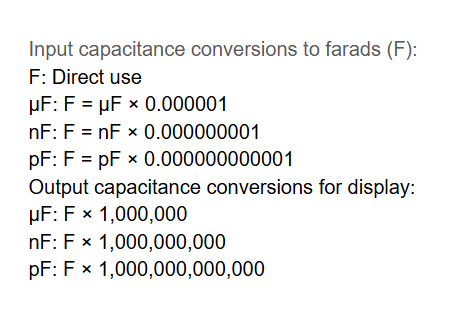 Home
Home
 Back
Back

Definition: This calculator converts a capacitance value from one unit to multiple other units, such as farads (F), microfarads (µF), nanofarads (nF), and picofarads (pF).
Purpose: It is used in electrical engineering and physics to easily convert capacitance values between different units, which is helpful when working with capacitors in circuits, datasheets, or theoretical calculations.
Capacitance is converted using:
Input capacitance conversions to farads (F):
Explanation: The input capacitance is converted to farads (F) using the appropriate conversion factor based on the selected unit. The capacitance is then converted to microfarads (µF), nanofarads (nF), and picofarads (pF) for display. Small values are shown in scientific notation for clarity.
Details: Capacitance values are often specified in different units depending on the context (e.g., farads for theoretical calculations, microfarads or picofarads for practical capacitors). Converting between units ensures compatibility when designing circuits, reading datasheets, or performing calculations.
Tips: Enter the capacitance (\( C \)) in F, µF, nF, or pF (must be greater than or equal to 0). The result will be the capacitance in farads (F), microfarads (µF), nanofarads (nF), and picofarads (pF). Values less than 0.00001 will be displayed in scientific notation.
Examples:
Q: What units are commonly used for capacitance?
A: Capacitance is commonly measured in farads (F), microfarads (µF), nanofarads (nF), and picofarads (pF). Farads are the SI unit, but µF, nF, and pF are more practical for most applications, as capacitors typically have small capacitance values.
Q: Why can’t the capacitance be negative?
A: Capacitance represents a physical property of a capacitor (its ability to store charge), which cannot be negative. A negative value would be physically meaningless in this context.
Q: What are typical capacitance values?
A: Typical values depend on the application. Electrolytic capacitors might be in the range of 1 µF to 1000 µF, ceramic capacitors are often 1 pF to 1 µF, and theoretical calculations might use farads for large systems.
Q: Why are small values displayed in scientific notation?
A: Values less than 0.00001 (e.g., \( 1 \times 10^{-5} \)) are displayed in scientific notation for clarity, as they are very small and would otherwise show as long strings of zeros in decimal format (e.g., 0.000000000001 F becomes \( 1.000000e-12 \, \text{F} \)).
Q: Why is the result displayed in multiple units (F, µF, nF, pF)?
A: Displaying the capacitance in farads, microfarads, nanofarads, and picofarads provides flexibility for different applications. For example, theoretical calculations might use farads, while practical circuit design often uses µF, nF, or pF.